
Hey y’all! Thanks so much for stopping by. My name is Laura and I am an Elementary School Counselor turned Curriculum Writer. At my precious school in Nashville, TN, 97% of my students were living in …
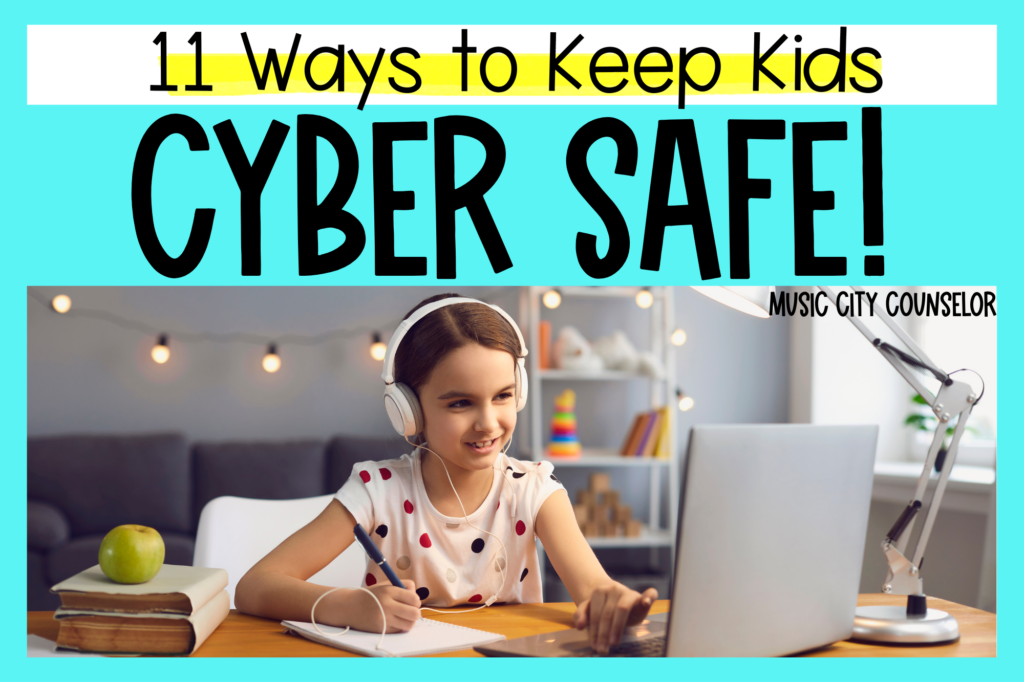
From online gaming to social media to YouTube, kids are hooked on technology more than ever before. Don’t get me wrong, technology has its benefits! There are countless meaningful and impactful educational tools that can boost kids’ math, reading, problem-solving skills, and more. And the chance to connect virtually with long-distance loved ones is priceless! But, as we all know, technology also brings with it major challenges and scary risks to our vulnerable kiddos.
To protect our kids, we must take the time to explicitly teach them cyber safety skills. Laying a strong foundation in elementary school gives kids the tools and knowledge they need to stay safe online.
Read on for 11 Ways to Keep Kids Cyber Safe: practical tips we can teach children that help them make safe and responsible choices in the digital world…and resources to help you do so!
Before we dive into my cyber safety tips, let’s briefly review the, “why.” What exactly are the negative impacts of technology on children?
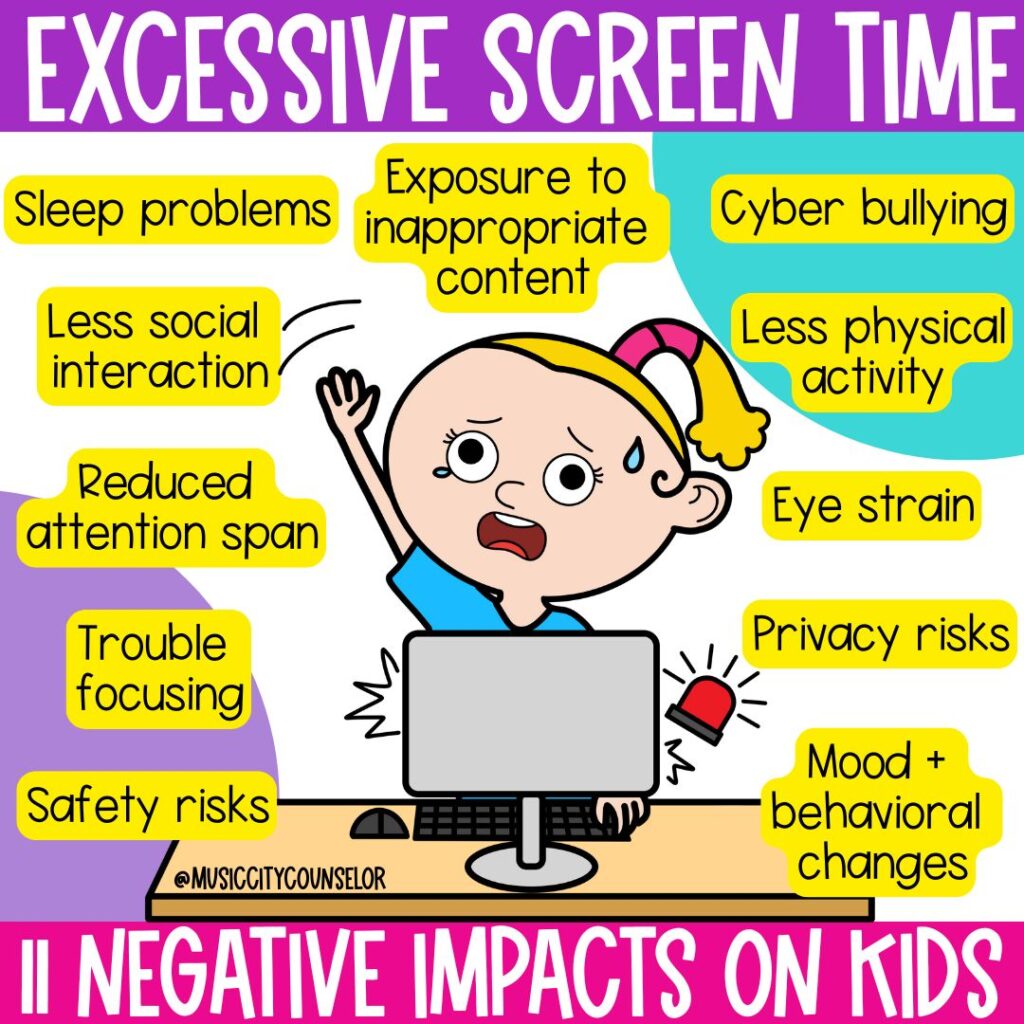
The scariest part? Our elementary friends just don’t have the awareness to recognize these online dangers or understand the consequences of the choices they make online. It’s our job as school counselors to teach and prepare them for the myriad of risks they’ll encounter in the digital world.

Now, let’s explore the 11 tips that my cyber safety lesson teaches kids to keep them safe online.
Encourage students and their caregivers to set reasonable time limits on screen time. As we discussed, excessive screen time can negatively impact children’s’ physical health, sleep, mood, social skills, communication skills, ability to focus, learning…and the list goes on! Setting screen time limits – and sticking to them – encourages a balanced lifestyle, allowing kids to explore a variety of activities that contribute to their well-being.
Giving kids free-range access to Internet-connected devices is just too risky. Teach kids to ask permission from a grown-up before going online. This helps them avoid unsafe websites, apps, or interactions they might not be ready for. It also gives caregivers a chance to guide kids toward age-appropriate content, set time limits, and ensure they use technology in ways that are safe and balanced. Remember, going online is both a privilege and a responsibility!
Teach students to only accept “friend” or follow requests from, and communicate with, people they know in real life. Strangers don’t need to know their business – and may not have good intentions with them! When kids connect only with real-life friends, they’re less likely to encounter someone who might share harmful content, spread rumors, or try to get personal information. This helps kids build a safe and positive online space, where they can chat and play with friends they know and trust, just like in the real world.

One of the most important things to teach kids is to keep their personal information private. Children should NEVER share their:
These crucial boundaries protect kids’ privacy and avoid risks online.
Along similar lines, kids should NEVER meet up with people they encounter online. These people very likely may not be who they claim to be. Meeting online strangers can lead to unsafe situations, and children may not recognize potential dangers until it’s too late.
Teach students that anything they share online can be posted there permanently. It can affect their reputation, privacy, safety, and future! Once something is posted, it can be shared literally worldwide and may be hard to remove, even if they delete it later. By thinking carefully about what they post, kids learn to protect their personal information, avoid negative attention, and create a positive digital footprint.
Teach kids to create a positive and respectful online experience for everyone. When they choose kind words and actions, they help prevent bullying, misunderstandings, and hurt feelings, which can easily happen in digital spaces where messages lack tone or context. Being kind online builds good friendships, encourages empathy, and shows others that the Internet can be a safe and supportive place. It also teaches kids that their actions have an impact, helping them develop responsible habits that carry over into real-life interactions.
Cyber bullying has real and lasting mental health impacts on children and adolescents. AMA Pediatrics found that victims of cyberbullying are more than twice as likely to experience suicidal thoughts and attempts compared to those not subjected to such harassment. Additionally, the Centers for Disease Control and Prevention (CDC) reported that 14.9% of adolescents have been cyberbullied, and 13.6% have made a serious suicide attempt.
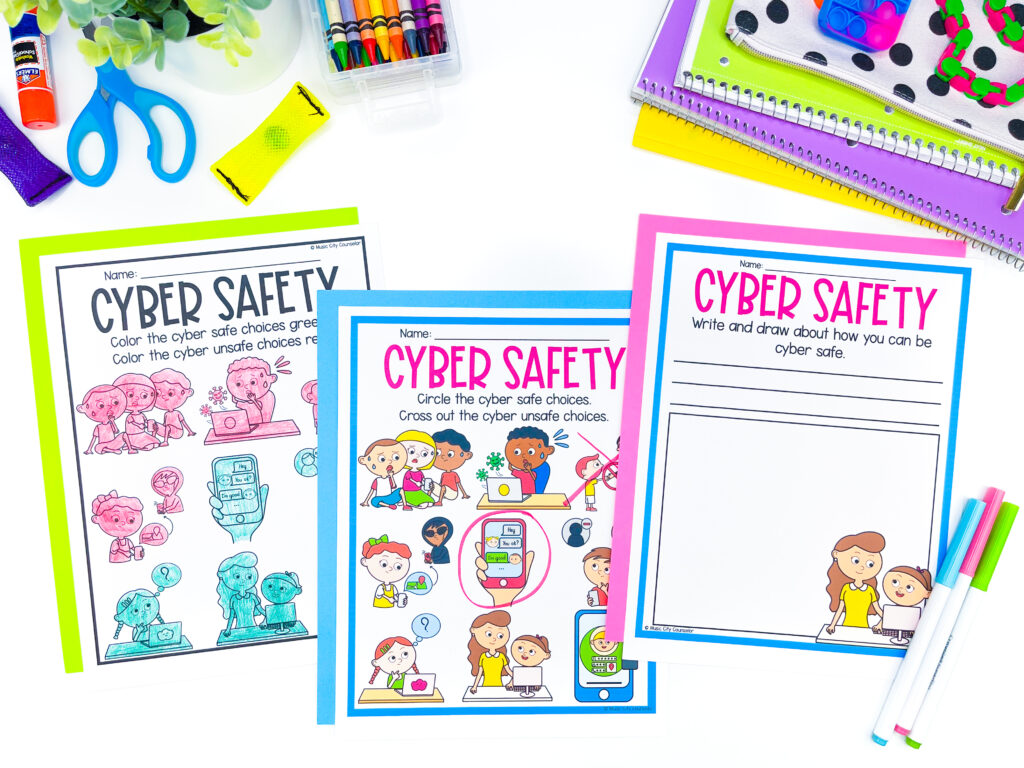
If something online feels fishy or mean, teach children to report it to a grown-up right away. Encourage kids to trust their gut! Caregivers can provide guidance and help block or report harmful users. Empower kids to speak up and show them that they don’t have to face online issues alone.
Teach kids about “click bait:” content that uses eye-catching or sensational headlines, images, or phrases to attract them to click. Clicking may bring them to an article or video that is disappointing, unrelated, misleading, or even harmful. Clicking haphazardly can also harm kids’ devices by downloading viruses or risk stealing their (or their parents’) personal information.
Along a similar note, teach kids to question what they read online. Just because it is posted online does NOT mean it’s true! Fact-checking is so important. Encourage kids to thoroughly research and read several different reliable sources before trusting what they read online. If they’re still unsure, they can always reach out to a grown-up they trust for further clarification.
Show kids how to create strong passwords to protect their personal information and online accounts from being accessed by others. Secure passwords make it harder for hackers or strangers to guess and prevent unwanted people from gaining access to their private information, messages, photos, and games.
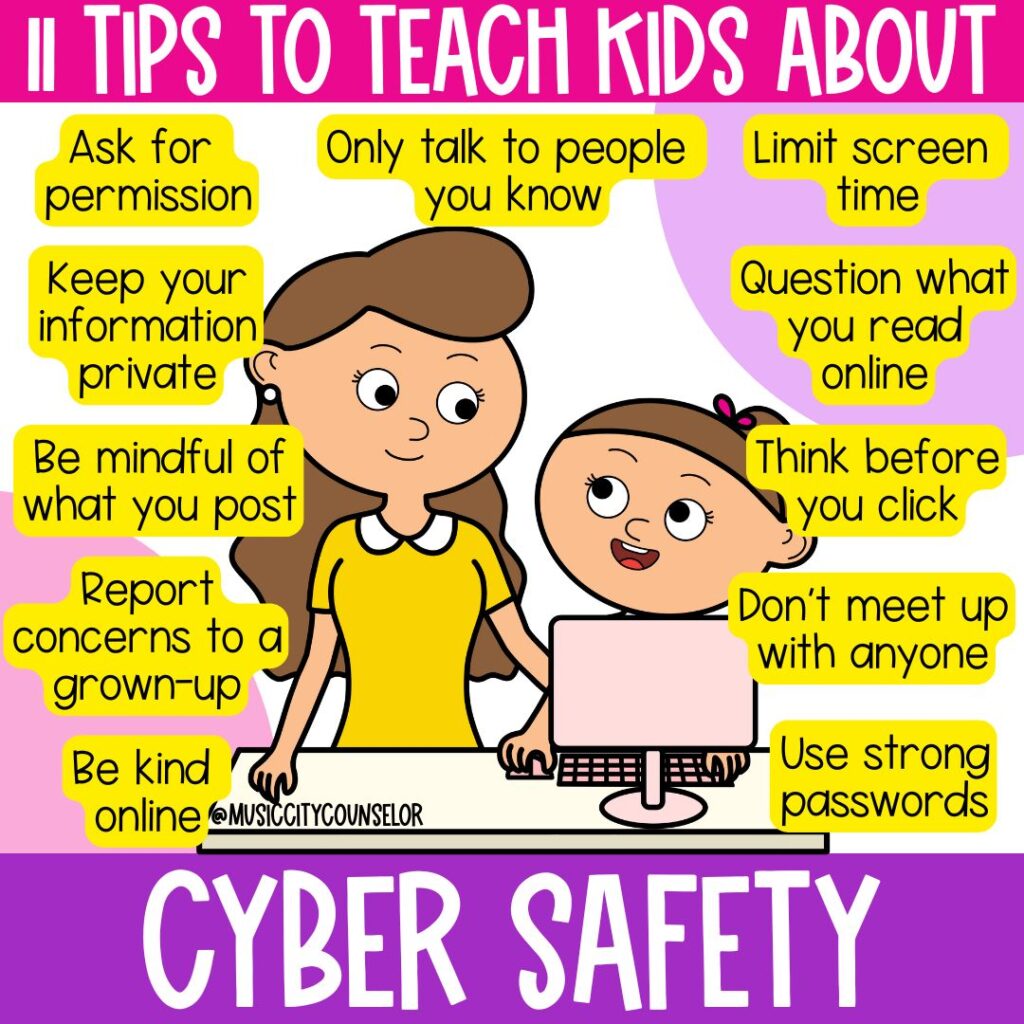

To check for understanding and reinforce these crucial life lessons, use my cyber safety lesson! It teaches kids the definition of cyber safety, the 11 ways to protect themselves and others online discussed in this post, the definition of cyberbullying, and examples of cyberbullying.
My favorite part of this lesson is the digital and printable sorting game. To play, students read 20 scenario cards and determine if the situation shows a “Cyber Safe” or “Cyber Unsafe” choice.
In the printable version of the game, students place the card in the “Cyber Safe” or the “Cyber Unsafe” bag.
In the digital version of the game, students drag the purple checkmark to the “Cyber Safe” or “Cyber Unsafe” box.


Close the lesson by asking your students to sign a Cyber Safety Pledge. My pledge included in this lesson let’s kids make a personal commitment to protecting their privacy, being kind online, and asking for help if they encounter something concerning. It also encourages accountability, making kids more mindful of their actions and decisions in the digital world. It also serves as a reminder that staying safe online is a shared responsibility and a positive habit for all of us.
I included both a lower elementary and an upper elementary version of the pledge – please choose the version that best meets the needs and abilities of your students!
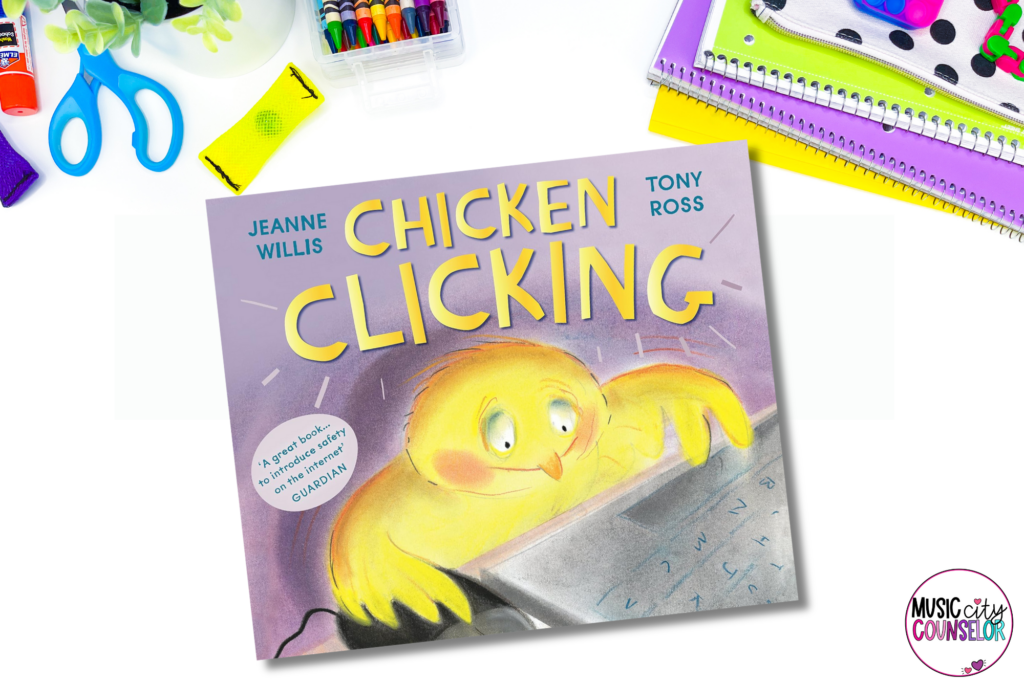
Finally, try incorporating kid-friendly books into your online safety instruction to raise awareness and foster discussion.
There aren’t many quality story books out there on the topic of cyber safety and digital citizenship, but this one is a WIN!
In “Chicken Clicking,” Chick gets onto the farmer’s computer and begins shopping for the entire farm. She buys a teapot, a motorbike, a hive of bees, and lots more! But one night as she’s clicking away, Chick decides to post pictures of herself and personal information. Then, she arranges to meet up with an online “friend.” What she doesn’t realize is her new “friend” isn’t who he claims to be. He’s actually a sly and cunning fox!
I love how this book is super kid-friendly with a farm setting, cute chick main character, and catchy rhyme scheme. But it still addresses crucial and sensitive topics that kids need to be aware of when it comes to using Internet-connected devices safely. I highly recommend it for lower elementary classroom lessons!
Remember, the earlier students understand the importance of cyber safety, the better they will be prepared to navigate the digital world around them. Thank you for taking the time to teach this critical content to your kiddos. You’re not just teaching lessons— you’re shaping their futures as they learn to become safe and responsible humans!

| Cookie | Duration | Description |
|---|---|---|
| cookielawinfo-checkbox-analytics | 11 months | This cookie is set by GDPR Cookie Consent plugin. The cookie is used to store the user consent for the cookies in the category "Analytics". |
| cookielawinfo-checkbox-functional | 11 months | The cookie is set by GDPR cookie consent to record the user consent for the cookies in the category "Functional". |
| cookielawinfo-checkbox-necessary | 11 months | This cookie is set by GDPR Cookie Consent plugin. The cookies is used to store the user consent for the cookies in the category "Necessary". |
| cookielawinfo-checkbox-others | 11 months | This cookie is set by GDPR Cookie Consent plugin. The cookie is used to store the user consent for the cookies in the category "Other. |
| cookielawinfo-checkbox-performance | 11 months | This cookie is set by GDPR Cookie Consent plugin. The cookie is used to store the user consent for the cookies in the category "Performance". |
| viewed_cookie_policy | 11 months | The cookie is set by the GDPR Cookie Consent plugin and is used to store whether or not user has consented to the use of cookies. It does not store any personal data. |